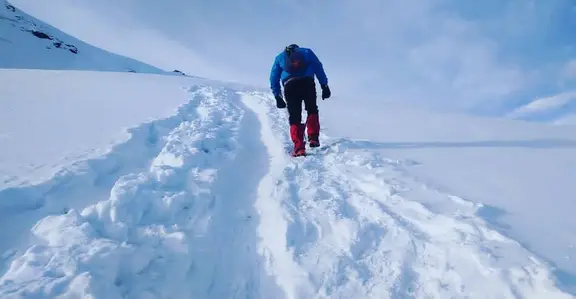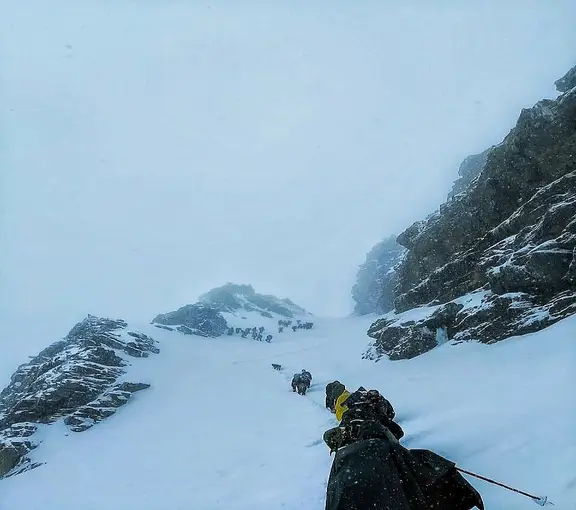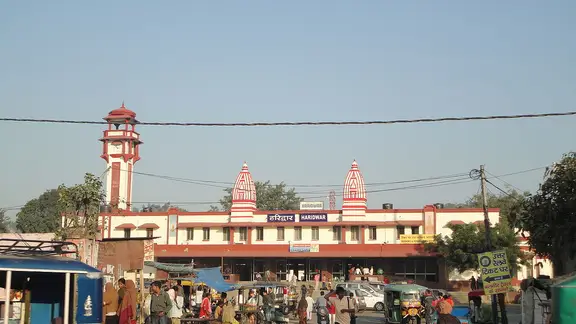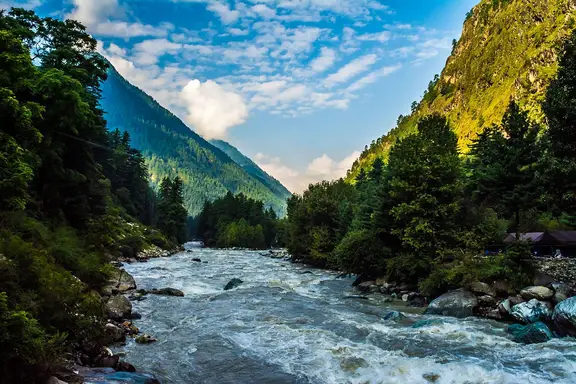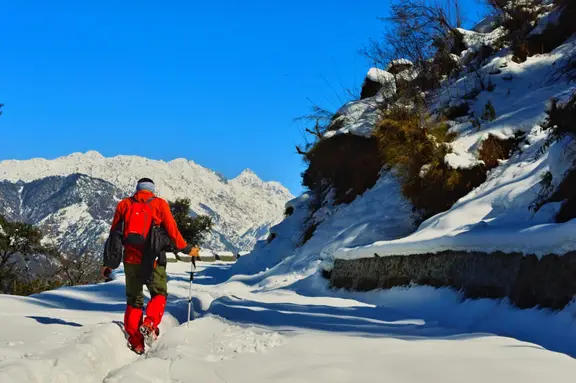Why should you choose Kedarkantha as your first Himalayan winter Trek?
Imagine, waking up one morning to the sound of a bell. It’s still dark outside and as you walk out of your tent, you smile at the sound of the fresh snow being crushed under your shoes. The cold mountain breeze makes you shiver.
Your friend calls you for tea and while you take a sip of it, your eyes fall on the edge of the mountain peak which now seems to have a golden lining. As you marvel at the golden hour of the dawn, you see the sun rising from behind the mountain, and you are rendered speechless by the sight of the changing hues of the sky and the display of warm colours on the snow.
About the Kedarkantha trek

With a stunning height of 12,500ft, located within Govind Wildlife Sanctuary in Uttarkashi district of Uttarakhand, the Kedarkantha trek provides awe-inspiring views of the mountains and nature. The trek’s uniqueness lies in the fact that it offers a peak summit and a lake campsite.
Even before the trek starts, the journey from Dehradun to Sankri is an experience in itself. You will pass through small towns like Mussoorie, Purola, Mori, Netwar and Motwat, and many more.
The road to Sankri runs along the Tons river, which happens to be the tributary of Yamuna.
As you drive away from the city life and the silence and music of nature engulf you, after a certain point in Mori, if you listen closely, you can hear the gurgling waters of the river Tons flowing along, making you feel the tranquillity of nature within yourself.
Along with all the calmness, the hairpin bends, the edge of the hills, the sunset, and the fading trails of light from the cars and human habitat gives you an adrenaline rush and a sense of adventure. This prepares you for the majestic experience you are going to have in the next 5 days.
Why choose Kedarkantha as your first Himalayan trek?
Some of us prefer the sea, while some prefer the hills. Preference or not, trekking takes up a special place in every traveller’s bucket list.
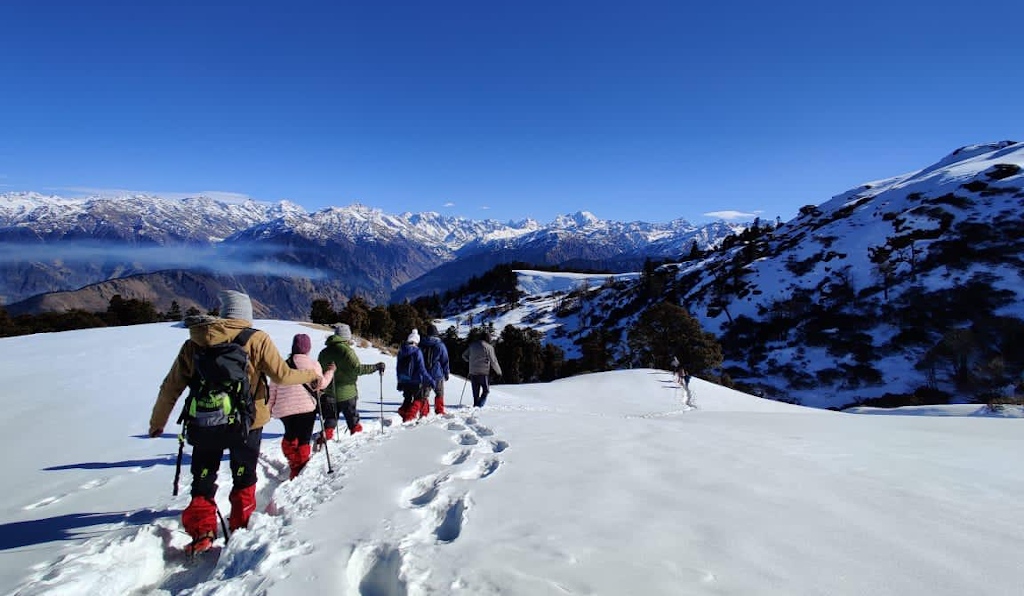
A mountain trek has been a compulsory thing in this generation’s wish list, especially after watching and marvelling at the experience their favourite characters are having in the famous Bollywood movie Yeh Jawani Hai Deewani. And any Himalayan trek remains incomplete without experiencing snow, so what can be better than to have a himalayan trek in the winters? But a mountain trek isn’t really a walk in the park and it does need a fair bit of stamina and physical fitness.
Kedarkantha, literally translated as Kedar-Kanth, is called Throat of Shiva. There are many legends and tales behind this place’s name and place itself making it all the more fascinating. Posing as a normal to moderate in the charts of difficulty level, Kedarkantha trek becomes an ideal choice for beginners and first-time trekkers to get them accustomed to the idea of trekking.
Although Kedarkantha is suitable for expert trekkers as well, it holds a special place for the first time trekkers to introduce themselves to the marvellous beauty of the majestic Himalayas.
Kedarkantha will make you feel the beauty and essence of the mountains and only a visit to it will make you realize why gods chose this place to reside.
The view of the sharp edges of the mountain ranges with sunlight glistening off the snow on its peaks, the rich flora and fauna, the spectacular lakes, the rich innocence of untouched nature, the view from the campsites, the touch of local lifestyle away from the chaotic urban rush and the silence is what makes things so perfect.
Is Kedarkantha Trek easy?
Kedarkantha is a peak and these Himalayan Peaks offer you the best panoramic views which cannot be missed. The mesmerizing view of the Swargrohini massif, the Bandarpunch ranges and the Gangotri ranges are the rewards of climbing the Kedarkantha Peak.
The trek to Kedarkantha Peak is comparatively easy to other Himalayan Peak Treks. For e.g., a trek to Pangarchulla Peak has a route of 44 km while this Kedarkantha Trek has only a distance of 18 km. And both the trek distances have to be covered in the same duration.
Comparing Kedarkantha Peak to another well-known trek Stok Kangri, the trek distance from the base camp to the peak is only 3 km as compared to the Stok Kangri trek which is 7 km. Also, the altitude gain from basecamp to the summit is 300 meters only which is 1000 meters in the case of Stok Kangri.
So, if you are looking for an easy peak trek with low altitude gain and less trekking distance, Kedarkantha should be on your list.
Why choose Kedarkantha trek in the winters?

Mountains are synonymous with snow. So, if you are opting for a trek in the Himalayas, what can be a better time for a trek in the mountains than the winter season. With winter starting from mid-November and lasting till April, you can expect to experience snow in the trek tracks till March/April.
Now, coming back to the question – ‘Why winters?’ – of all the mountain ranges and the trek routes that the Himalayas have to offer, Kedarkantha stands different for its clearings along the trail tracks, you will come across clearings where you can see vast stretches of majestic fresh white snow, formed overnight on the ground and the black rocks, creating a beautiful contrast and a scenic beauty that’s one of its kind.
What’s more is that the snow is virgin and untouched, which crumbles under your every step and falls off your hand like grains of sand when you try to pick it up. The feeling and the sensation of fresh snow on your palm and under your feet is euphoric.
Kedarkantha trek in the winters is an experience that one must-have. Kedarkantha pulls you away from the mundane city life and its chaos and drops you amidst nature making you sense its calmness deep within you. From the falls and rivers during the journey to the fresh winter snow falling from the sky and the blanket of the galaxy on top of you at night, the trek is any photographer’s paradise.
That being said, it is important to note that Sankri being a part of a wildlife sanctuary, flying drones is prohibited – yet the aerial view during the journey from Dehradun to Sankri is worth the effort of carrying one. Watch out for the local delicacies at Sankri and on your way back do not forget to check out the handmade goods and the wooden toys and decors that the locals make, which can serve as a perfect souvenir for this trek.
Things to look out for in Kedarkantha trek
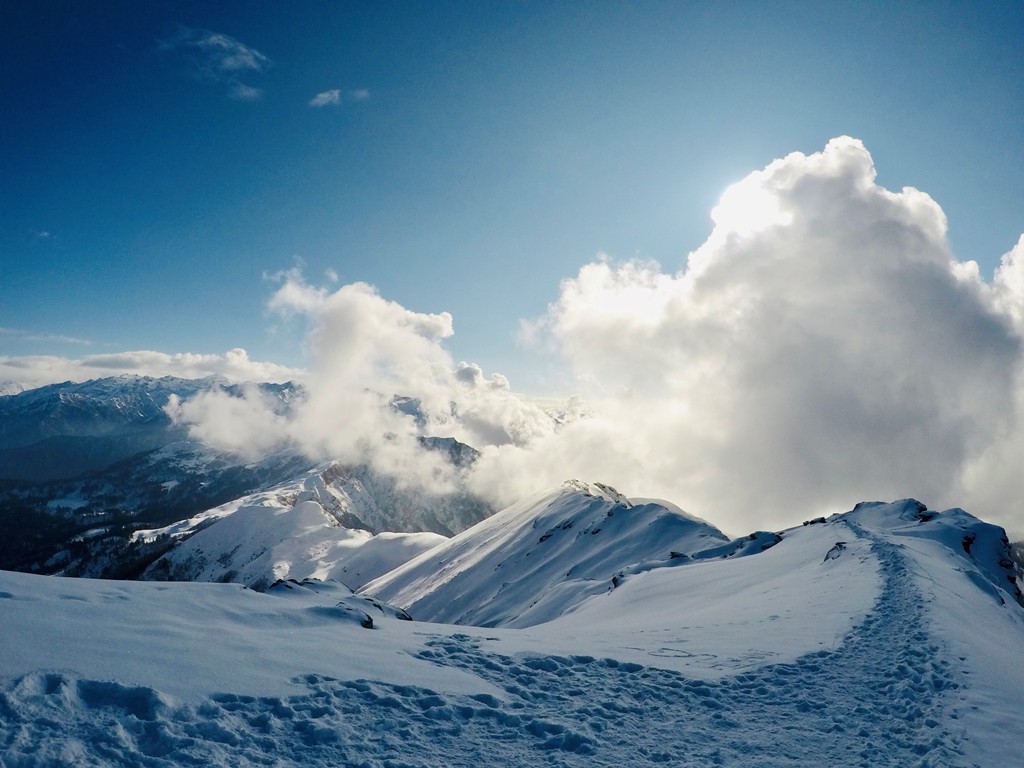
The Kedarkantha trek trail is popular for the beauty of the trail.
When you are trekking and walking towards the next camp, you have to walk through the vegetation of oak, pine, and maple trees which has experienced snowfall last night. So when you walk, you can experience light soft snow dust falling off the leaves on you. This, with the warmth of the slanting rays of the sun hitting you and warming you up, it is a feeling made in heaven.
Juda ka Talab:
At 9,100ft, Juda ka Talab campsite offers an amazing view of the lake surrounded by mountain slopes with tall pine and oak trees growing along with it. It is located 4kms from Sankri.
Being winter the lake is frozen solid, and you get to walk on it. Standing in the middle of a frozen lake, in itself is a biblical feeling as a whole.
Mythology tales suggest that this lake was formed when a few drops of water dropped here from the strands of Shiva’s hair.
Also, few locals believe that the lake is connected with another lake underneath it, hence the name Juda or connected.
360-degree View from Kedarkantha summit:
In the end, when you finally reach the summit and the feeling of the achievement seeps in, you realize that the view from the peak of the Himalayas is worth all the effort.
The view and the silence of the mountains add to the bliss of the climb. The clarity and the peace that being on top of the majestic Himalayas is addictive enough to make you get into the habit of trekking.
From the summit, you can see the other peaks like Nanda Ghunti, Swargarohini, Kalanag peak, Bandarpunch mountains, Yamunotri range, Jaonti, Gangotri, Draupadi ka Danda, Jorkanden along with Rupin valley and Har ki Dun valley.
Kedarkantha Mythology:
According to Hindu mythology, Lord Shiva was looking for a peaceful place to meditate and have his temple built on. He choose this peak to become what we know as Kedarkantha. But with villages and locals living nearby, one morning his mediation was interrupted by the mooing of a cow, which made him leave the spot and shift to what we came to know as Kedarnath. Meanwhile, with his meditation interrupted, his temple was only half-built, to be more specific, till his throat – hence the name Kedar-Kanth or Kedarkantha.
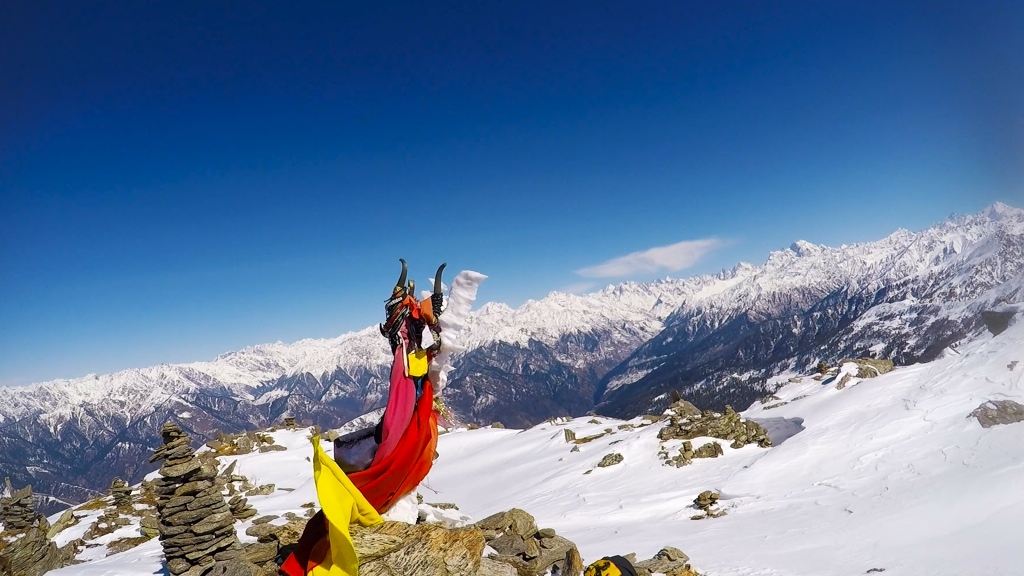
The shrine at the top of the Kedarkantha adds life to this tale.
Also in Sankri, you will find many Himalayan Bhotia dogs that are all adorable and cute looking for treats while trying to be friendly with you.
Since you don’t have any cell network from Sankri, you might as well befriend the locals and interact with the trek leaders to know about the folklore, tales, and stories this place has to offer.
Tips for the Kedarkantha trek
Pack light: Pack things that you are sure will be necessary for the next 6 days of your trek, for you will be carrying the load on your back.
Take layered clothing: Keep in mind that you are planning a mountain trek in the winters where temperatures drop below minus zero quite often. Do take your thermals and your windcheaters.
Plan on layering up to retain more body heat and also because it can allow you to free yourself up if you feel warm and thus adjust accordingly.
Good trekking shoes: Shoes are very important in a trek like this, especially in the winters. Proper trekking shoes are important, if you don’t have one, talk to the organizers at Moxtain for waterproof trekking shoes.
They are available for rent along with other trekking gears like a hiking backpack, hiking waterproof poncho, and hiking stick
Stay hydrated: A trek in the mountains and the climb will draw out your energy, and proper hydration is what will save you from tiring out.
Although the Kedarkantha trek has enough breaks in between, making it perfect for a first-time trekker to get used to the experience of trekking, keep drinking water to keep yourself hydrated and energized.
Take care of the environment: The ecosystem up there is very fragile and you mustn't litter as the temperature there makes things hard to decompose.
Please don’t throw away the wrappers and plastics but carry it with you and dump them at proper disposal sites only. Try to carry disposable and biodegradable products with you.
With all said and done, its time you get yourself ready for the trek that you have been procrastinating about for so long. Take out your trekking bags and boots and join us for your first Himalayan winter trek to the Kedarkantha summit this winter season.
Good Luck!!!



